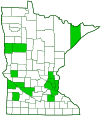short-winged meadow katydid
(Conocephalus brevipennis)
Conservation • Description • Habitat • Ecology • Distribution • Taxonomy
Conservation Status |
|
|||||||
| IUCN Red List | not listed |
|||||||
| NatureServe | NNR - Unranked |
|||||||
| Minnesota | not listed |
|||||||
Description |
||
Short-winged meadow katydid is a small, easily overlooked, lesser meadow katydid. It occurs in the United States and southern Canada east of the Great Plains and in southern Mexico. It is common in the east, less common in Minnesota, where it reaches the western extent of its range. Adults are found from early August to late September in wet fields, damp meadows, and marshes, on roadsides, and in shaded areas at the edges of streams. They can be difficult to find. When approached, they will stretch out and cling to the underside of a grass blade. Adults are slender and ½″ to ⅝″ (12 to 16 mm) in length. The head is slanted in front. When viewed from the side, the face is at an angle less than 90° to the top of the head. At the top of the head (vertex) a rounded projection projects beyond the bases of the antennae but not beyond the first antennal segment. The antennae are slender and long, much longer than the body. A dark brown to almost black stripe extends from the top of the head to the wing bases. The face is green with scattered black dots. On the underside of the thorax, the frontmost plate (prosternum) has two spines. The abdomen is mostly green but orange at the tip and brown above. On the female the egg-laying appendage (ovipositor) at the end of the abdomen is blade-like, sharply pointed, slender, straight, and long, as long as or slightly shorter than the abdomen. On the male, the pair of appendages at the tip of the abdomen (cerci) are orange. There is a single tooth on the inner margin at or before the middle of each cercus. Beyond the tooth the cercus is flattened or concave on the inner surface. The forewings (tegmina) are leathery, brown, translucent, and usually short. They normally cover one-third to four-fifths of the abdomen. They rarely extend beyond the end of the abdomen. The legs are green. On the front legs, the third segment (femur) has no spines on the underside. On the front and middle legs, the fourth segment (tibia) has six well-spaced spines on the underside. On the hind legs, the femur has no spines on the underside, and the tibia has three pairs of spurs at the end. The last part of each leg (tarsus), corresponding to the foot, has four segments. |
||
Size |
||
½″ to ⅝″ (12 to 16 mm) |
||
Song |
||
The song of the male is faint, buzzing, and very high pitched. It consists of one to five ticks, followed by a buzz lasting one-half to two seconds. The series is repeated three to five times in five seconds. Most of the sound is in the 10 to 20 kHz range. Most adult humans above the age of 25 cannot hear sounds above 15 kHz. |
||
Similar Species |
||
Habitat |
||
Damp meadows and marshes and at the edges of streams |
||
Ecology |
||
Season |
||
Early August to late September (CCESR) |
||
Behavior |
||
|
||
Life Cycle |
||
|
||
Larva Food |
||
|
||
Adult Food |
||
|
||
Distribution |
||||
|
Sources |
|||
| 12/5/2022 | ||||
Occurrence |
||||
Common |
||||
Taxonomy |
|||
Order |
Orthoptera (grasshoppers, crickets, and katydids) | ||
Suborder |
Ensifera (katydids, crickets, and allies) | ||
| Infraorder | Tettigoniidea (katydids, wētā, and allies) | ||
Superfamily |
Tettigonioidea | ||
Family |
Tettigoniidae (katydids) | ||
Subfamily |
Conocephalinae (coneheads and meadow katydids) | ||
Tribe |
Conocephalini (common meadow katydids) | ||
Genus |
Conocephalus (lesser meadow katydids) | ||
| Subgenus | Conocephalus | ||
Subordinate Taxa |
|||
short-winged meadow katydid (Conocephalus brevipennis brevipennis) |
|||
Synonyms |
|||
Anisoptera brevipennis Xiphidium brevipennis Xiphidium ensifer Xiphidium ensiferum Xiphidium gossypii |
|||
Common Names |
|||
short-winged meadow grasshopper short-winged meadow katydid |
|||
Glossary
Cercus
One of a pair of small sensory appendages at the end of the abdomen of many insects and other arthropods. In Odonata, one of the upper claspers. Plural: cerci.
Femur
On insects and arachnids, the third, largest, most robust segment of the leg, coming immediately before the tibia. On humans, the thigh bone.
Ovipositor
A tube-like organ near the end of the abdomen of many female insects, used to prepare a place for an egg and to place the egg.
Tarsus
On insects, the last two to five subdivisions of the leg, attached to the tibia; the foot. On spiders, the last segment of the leg. Plural: tarsi.
Tegmen
The modified, leathery front wing of grasshoppers and related insects that protects the hindwing. It may also serve as a camouflage, a defensive display, or a sound board. Plural: tegmina.
Tibia
The fourth segment of an insect leg, after the femur and before the tarsus (foot). The fifth segment of a spider leg or palp. Plural: tibiae.
Vertex
The upper surface of an insect’s head.
Visitor Photos |
|||||
Share your photo of this insect. |
|||||
| This button not working for you? Simply email us at info@MinnesotaSeasons.com. Attach one or more photos and, if you like, a caption. |
|||||
Alfredo Colon |
|||||
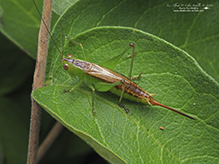 |
|||||
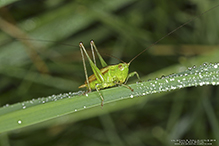 |
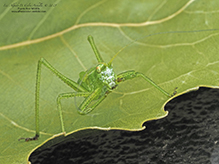 |
||||
Babette Kis |
|||||
Conocephalus brevipennis (short-winged meadow katydid) Conocephalis brevipennis, short-winged meadow katydid, photographed on Barnes Prairie, Racine Co., WI on October 9, 2021. They're difficult to photograph, as the ones I've seen stay low in the grasses. |
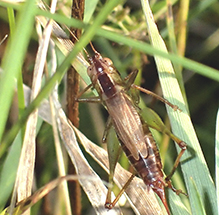 |
||||
MinnesotaSeasons.com Photos |
|||||
|
|||||

Slideshows |
||

Visitor Videos |
|||
Share your video of this insect. |
|||
| This button not working for you? Simply email us at info@MinnesotaSeasons.com. Attach a video, a YouTube link, or a cloud storage link. |
|||
Other Videos |
|||
| Short Winged Meadow Katydids (Conocephalus brevipennis) Timothy Johnston |
|||
About
Oct 16, 2019 One of our most abundant Katydids. However, they are difficult to hear because their songs are so high pitched. |
|||
| SHORT-WINGED MEADOW GRASSHOPPER stridulating. Conocephalus brevipennis Rob Curtis |
|||
About
Oct 27, 2016 onocephalus brevipennis SHORT-WINGED MEADOW GRASSHOPPER stridulating. At 10K-20K cycles/second, beyond my hearing, but I tried to boost it with EQ. |
|||
| Female Meadow Katydid (Conocephalus brevipennis) Mark Berman |
|||
About
Apr 10, 2012 |
|||


Created: 12/5/2022
Last Updated:
